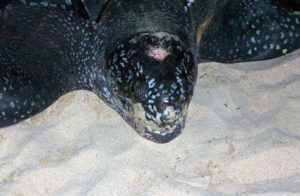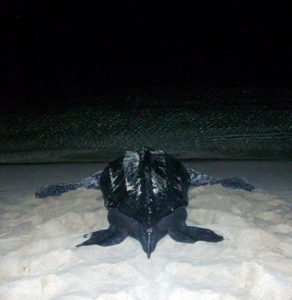 Hello, Frank Indiviglio here. Today I’d like to highlight some simple ways that you can become involved in hands-on research with marine animals. Next time we’ll take a look at programs designed for people interested in fishes.
Hello, Frank Indiviglio here. Today I’d like to highlight some simple ways that you can become involved in hands-on research with marine animals. Next time we’ll take a look at programs designed for people interested in fishes.
Sea Turtle Research in Costa Rica
The Caribbean Conservation Corporation, founded in 1959 by legendary turtle biologist Archie Carr, was the world’s first marine turtle protection organization. Promoting conservation through research, and political advocacy, CCC is based in Florida, and its primary field station is nestled between rainforest and sea at Tortuguero National Park, Costa Rica. Volunteer researchers have always figured prominently in the group’s work, and today a number of interesting opportunities are available.
Sea Turtles, Jaguars and Frogs … My Experience with CCC
My first field trip to Tortuguero, working with green turtles and 1,500 pound leatherbacks, hooked me for life. I and other researchers tagged and measured turtles, counted eggs, and monitored nests.
I also participated in studies focusing on the area’s 300+ bird species and was lucky enough to see kinkajous, caimans, ocelots, tapirs, jaguar tracks (overlapping my own!), arboreal tarantulas, strawberry poison frogs and a host of other incredible animals.
Working with Seals
 Seals of several species are becoming increasingly common in coastal urban areas, where they face threats from boat collisions, harassment and pollution-related diseases. The Seal Conservation Society maintains a comprehensive list of organizations that assist injured seals and provides information for those interested in becoming wildlife rehabilitators, beach monitors or “seal watch” tour leaders.
Seals of several species are becoming increasingly common in coastal urban areas, where they face threats from boat collisions, harassment and pollution-related diseases. The Seal Conservation Society maintains a comprehensive list of organizations that assist injured seals and provides information for those interested in becoming wildlife rehabilitators, beach monitors or “seal watch” tour leaders.
Untrained people should not approach seals – injured animals and females returning from hunting to claim their pups can be extremely dangerous. In the USA, sick or harassed seals can be reported to the local police or the National Oceanographic and Atmospheric Administration’s 24 hour emergency hotline: 800-853-1964.
Helping a Living Fossil
Most people do not realize that no intravenous drug produced in the USA reaches the market without first having been tested with a chemical produced by an ocean-dwelling relative of the spiders.
Compounds within the blood of the horseshoe crab (Limulus polyphemus) far surpass synthetics in detecting drug impurities. Biomedical companies draw blood from millions of these ancient (as in “unchanged for over 200 million years”!) creatures yearly. Although horseshoe crabs harvested for blood samples are released, coastal development and collection for the bait trade has caused US populations to plummet.
Based in the Northeastern USA, Project Limulus relies upon volunteers to monitor over 5,000 spawning horseshoe crabs each spring in an effort to help formulate conservation strategies.
Over 17,000 horseshoe crabs have been tagged by US Geological Service volunteers working along the Delaware Bay. Their work seeks to assist both horseshoe crabs and a shorebird known as the red knot. Undertaking one of the longest known bird migrations (Argentina to the Arctic), red knots somehow time a stopover on their trip to coincide with the spawning of the Delaware Bay horseshoe crab population. Red knots rely upon horseshoe crab eggs to fuel the last leg of their amazing journey, and have suffered massive declines since this food source has become scarce.
Further Reading
Please see my article Hands on Experiences in Sea Turtle Conservation for further information on working in Tortuguero, Costa Rica.
Well, that’s just the tip of the iceberg…please write in if you are interested in other research opportunities. I’ll cover fish-oriented programs in the future. Thanks, until next time, Frank Indiviglio.
 That Fish Blog – Aquarium Advice and Information
That Fish Blog – Aquarium Advice and Information

 During my college days, I participated in loggerhead sea turtle nesting studies and research along the South Carolina coast. Our volunteers would walk the beach every morning looking for the telltale “crawl”, the tracks made by the female turtle as she crawled up the beach to lay her nest, but we very rarely ever caught a glimpse of the turtle in action.
During my college days, I participated in loggerhead sea turtle nesting studies and research along the South Carolina coast. Our volunteers would walk the beach every morning looking for the telltale “crawl”, the tracks made by the female turtle as she crawled up the beach to lay her nest, but we very rarely ever caught a glimpse of the turtle in action.
 Some of our smaller sunfishes have long been popular with aquarists in Europe, but in the USA native fish-keeping is a lost (or barely developed!) art. I do not quite understand why, as many are interesting, brilliantly colored and little-studied. Species diversity here is quite high…even over-crowded New York State boasts nearly 150 freshwater fishes, many of which do quite well in captivity (interesting note: more species of fish have been identified in the Amazon River than in the entire Atlantic Ocean!).
Some of our smaller sunfishes have long been popular with aquarists in Europe, but in the USA native fish-keeping is a lost (or barely developed!) art. I do not quite understand why, as many are interesting, brilliantly colored and little-studied. Species diversity here is quite high…even over-crowded New York State boasts nearly 150 freshwater fishes, many of which do quite well in captivity (interesting note: more species of fish have been identified in the Amazon River than in the entire Atlantic Ocean!).